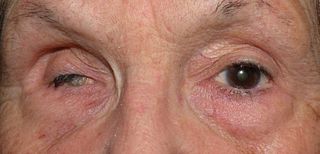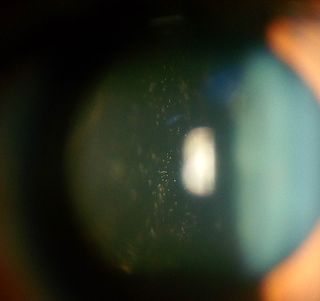This article needs additional citations for verification .(February 2014) (Learn how and when to remove this template message) |
| Toxic anterior segment syndrome | |
|---|---|
| Specialty | Ophthalmology |
Toxic anterior segment syndrome is an acute, sterile anterior segment inflammation following generally uneventful cataract and anterior segment surgery. [1]

Inflammation is part of the complex biological response of body tissues to harmful stimuli, such as pathogens, damaged cells, or irritants, and is a protective response involving immune cells, blood vessels, and molecular mediators. The function of inflammation is to eliminate the initial cause of cell injury, clear out necrotic cells and tissues damaged from the original insult and the inflammatory process, and initiate tissue repair.

A cataract is a clouding of the lens in the eye which leads to a decrease in vision. Cataracts often develop slowly and can affect one or both eyes. Symptoms may include faded colors, blurry vision, halos around light, trouble with bright lights, and trouble seeing at night. This may result in trouble driving, reading, or recognizing faces. Poor vision caused by cataracts may also result in an increased risk of falling and depression. Cataracts cause half of all cases of blindness and 33% of visual impairment worldwide.
One of the main factors in differentiating toxic anterior segment syndrome from an infectious endophthalmitis is the rapid onset. Most patients with toxic anterior segment syndrome will develop symptoms within 12 to 24 hours of the surgery. Common findings on anterior segment slit lamp examination include increased cell and flare with associated fibrin and possible hypopyon formation. Patients may show signs of diffuse corneal edema, and they may also show signs of iris atrophy with pupillary abnormalities and eventual increased intraocular pressure.

Endophthalmitis is an inflammation of the interior of the eye. It is a possible complication of all intraocular surgeries, particularly cataract surgery, with possible loss of vision and the eye itself. Infectious cause is the most common and various bacteria and fungi have been isolated as the cause of the endophthalmitis. Other causes include penetrating trauma, allergic reaction, and retained intraocular foreign bodies. Intravitreal injections expose patients to the risk of endophthalmitis, but with an incidence rate usually less than .05%.

The slit lamp is an instrument consisting of a high-intensity light source that can be focused to shine a thin sheet of light into the eye. It is used in conjunction with a biomicroscope. The lamp facilitates an examination of the anterior segment and posterior segment of the human eye, which includes the eyelid, sclera, conjunctiva, iris, natural crystalline lens, and cornea. The binocular slit-lamp examination provides a stereoscopic magnified view of the eye structures in detail, enabling anatomical diagnoses to be made for a variety of eye conditions. A second, hand-held lens is used to examine the retina.

Fibrin is a fibrous, non-globular protein involved in the clotting of blood. It is formed by the action of the protease thrombin on fibrinogen which causes it to polymerize. The polymerized fibrin together with platelets forms a hemostatic plug or clot over a wound site.
It is important to differentiate sterile postoperative inflammation from infectious endophthalmitis because the treatments of these patients are markedly different. Patients with toxic anterior segment syndrome will often respond rapidly to treatment with topical corticosteroids, while infectious endophthalmitis must be treated with antibiotics. It is important that the patients be evaluated often to ensure that the inflammation is clearing and that the patient's intraocular pressure is under control. The clearing of the inflammation and eventual patient outcome is related to the severity of the toxic insult at the time of surgery. Most patients reported to date are in the category of a moderate toxic inflammation.

Corticosteroids are a class of steroid hormones that are produced in the adrenal cortex of vertebrates, as well as the synthetic analogues of these hormones. Two main classes of corticosteroids, glucocorticoids and mineralocorticoids, are involved in a wide range of physiological processes, including stress response, immune response, and regulation of inflammation, carbohydrate metabolism, protein catabolism, blood electrolyte levels, and behavior.

Intraocular pressure (IOP) is the fluid pressure inside the eye. Tonometry is the method eye care professionals use to determine this. IOP is an important aspect in the evaluation of patients at risk of glaucoma. Most tonometers are calibrated to measure pressure in millimeters of mercury (mmHg).
Toxic anterior segment syndrome may be related to problems with any irrigating solution or other solution placed in the patient's eye during surgery, including balanced salt solution or anything added to solutions. Material placed in the eye during surgery such as anesthetics, ophthalmic viscoelastic devices, antibiotics, or other medications has been associated with toxic anterior segment syndrome. Problems related to the cleaning and sterilization of instruments for cataract surgery have been found to be a cause.
A balanced salt solution (BSS) is a solution made to a physiological pH and isotonic salt concentration. Solutions most commonly include sodium, potassium, calcium, magnesium, and chloride. Balanced salt solutions are used for washing tissues and cells and are usually combined with other agents to treat the tissues and cells. They provide the cells with water and inorganic ions, while maintaining a physiological pH and osmotic pressure.

An anesthetic or anaesthetic is a drug used to induce anesthesia - in other words, to result in a temporary loss of sensation or awareness. They may be divided into two broad classes: general anesthetics, which cause a reversible loss of consciousness, and local anesthetics, which cause a reversible loss of sensation for a limited region of the body without necessarily affecting consciousness.












